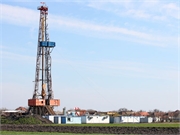- Skip Storing This Everyday Product in the Fridge Door
- Green Tea + B3 Pairing May Boost Brain Health
- Navigating Your Midlife Crisis: Embracing New Possibilities
- City Raccoons Showing Signs of Domestication
- Mapping the Exposome: Science Broadens Focus to Environmental Disease Triggers
- One Week Less on Social Media Linked to Better Mental Health
- Your Brain Changes in Stages as You Age, Study Finds
- Some Suicide Victims Show No Typical Warning Signs, Study Finds
- ByHeart Formula Faces Lawsuits After Babies Sickened With Botulism
- Switch to Vegan Diet Could Cut Your Greenhouse Gas Emissions in Half
Living Near Oil, Gas Wells Tied to Low Birth Weight Infants

Pregnant women who live near active oil and gas wells may be at risk for having low birth weight infants, a new study suggests.
Researchers analyzed nearly 3 million births to Californians living within six miles of an oil or gas well between 2006 and 2015.
It was found that women living within less than a mile of a well were 40% more likely to have low birth weight infants and 20% more likely to have babies who were small for their gestational age, compared with women who lived farther away from wells.
“Being born of low birth weight or small for gestational age can affect the development of newborns and increase their risk of health problems in early childhood and even into adulthood,” said researcher Rachel Morello-Frosch, a professor of public health and environmental science, policy and management at the University of California, Berkeley.
Full-term babies near wells were an average of 1.3 ounces (36 grams) smaller than babies who were not near wells, according to the findings.
“When you see a shift of over 30 grams of birth weight among term infants, from an individual clinical perspective, it may not seem like a lot,” Morello-Frosch said in a university news release. “But when you see that kind of large population shift in birth weight — that can have significant population level implications for infant and children’s health.”
Women in rural areas were more likely to have low birth weight babies than women in urban areas, the researchers found. It’s not clear why there are differences in birth weight in rural and urban areas, but the researchers speculate that factors such as differences in indoor air quality, the mother’s occupation or housing might play a part.
“This study is the first to characterize the implications for perinatal health of active oil and gas production in the state, and I think the results can inform decision-making in regulatory enforcement and permitting activities,” Morello-Frosch said.
The researchers pointed out that oil and gas sites often produce air and water pollutants, excess lighting and noise. But because they could not access the sites themselves, it’s difficult to say what exactly is contributing to birth outcomes. Also, only an association was observed rather than a cause-and-effect link.
“Results from health studies such as ours support recent efforts to increase buffers between active well activities and where people live, go to school and play,” Morello-Frosch added.
“This scientific evidence of adverse health effects facing vulnerable populations, including pregnant women, should be taken into account as Californians debate the extent to which we too want to expand oil and gas drilling in our state,” she said.
The report was published June 3 in the journal Environmental Health Perspectives.
More information
For more on low birth weight infants, see the March of Dimes.
Source: HealthDay
Copyright © 2025 HealthDay. All rights reserved.










